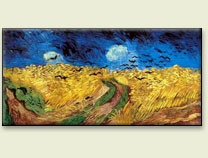Yellow is the color of the light and warmth and has a stimulating, lightening and warming effect on the soul. Goethe wrote in his Color theory (Farbenlehre):
"In its purest form it carries its bright nature in itself and is of light, spirited, slightly provoking character (...) So it is generally known that yellow makes a warm and cozy impression. We find it in paintings on the illuminated and active side. This warming effect can be felt distinctly by observing a winter landscape through an yellow glass. There is joy for the eye, widening of the heart and lifting of the spirit; a tangible warmth seems to emanate from the glass."
W. Kandinsky describes a different effect of the (glaring) yellow in his book Concerning the spiritual in art:
"Yellow, if steadily gazed at in any geometrical form, has a disturbing influence, and reveals in the color an insistent, aggressive character. (It is wort noting that the sour-tasting lemon and shrill-singing canary are both yellow.) The intensification of the yellow increases the painful shrillness of its note."
Both quotes emphasize the conflicting effects of yellow. Warm golden yellow is perceived in a different way than the loud yellow of a lemon which is sometimes associated with mental deviations.
Yellow was Vincent Van Gogh’s favorite color. He preferred yellow ochre in the beginning of his career, adding the newly discovered pigments cadmium yellow and chrome yellow later on. He transformed the light in his landscapes into pure color. Light signified to him the Sun of the South, lightness of spirit in addition to friendship and love. Van Gogh used yellow in context with its complementary color - blue. He saw power and the entirety of life in the combination of both colors (cf. Wheat fields with crows, 1890). Yellow of Van Gogh mirrors his quest for cheerful and lighthearted life which he was never able to live and also expresses the creative energy innate in this artist.
Yellow can be discerned from the greatest distance. Traffic signs, changing traffic lights, life jackets and tennis balls are all yellow. Yellow (sometimes orange) labels are used to designate hazardous substances. Players in European soccer are warned by an yellow card for their foul play by the referee and yellow flag on ship signals the outbreak of an epidemic. Yellow and red signal danger and venom in animal kingdom (spotted salamander, hornet).
Warm yellow is used in advertising to suggests light and peaceful feelings.
(main yellows page) - Naples yellow - Orpiment - lead tin yellow - Orpiment - cadmium yellow - chrome yellow - - Yellow ochre - Cobalt yellow - Indian yellow - Lemon yellow

